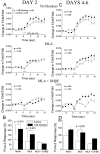Assembly of alpha4beta2 nicotinic acetylcholine receptors assessed with functional fluorescently labeled subunits: effects of localization, trafficking, and nicotine-induced upregulation in clonal mammalian cells and in cultured midbrain neurons
- PMID: 14684858
- PMCID: PMC6740951
- DOI: 10.1523/JNEUROSCI.23-37-11554.2003
Assembly of alpha4beta2 nicotinic acetylcholine receptors assessed with functional fluorescently labeled subunits: effects of localization, trafficking, and nicotine-induced upregulation in clonal mammalian cells and in cultured midbrain neurons
Abstract
Fura-2 recording of Ca2+ influx was used to show that incubation in 1 microm nicotine (2-6 d) upregulates several pharmacological components of acetylcholine (ACh) responses in ventral midbrain cultures, including a MLA-resistant, DHbetaE-sensitive component that presumably corresponds to alpha4beta2 receptors. To study changes in alpha4beta2 receptor levels and assembly during this upregulation, we incorporated yellow and cyan fluorescent proteins (YFPs and CFPs) into the alpha4 or beta2 M3-M4 intracellular loops, and these subunits were coexpressed in human embryonic kidney (HEK) 293T cells and cultured ventral midbrain neurons. The fluorescent receptors resembled wild-type receptors in maximal responses to ACh, dose-response relations, ACh-induced Ca2+ influx, and somatic and dendritic distribution. Transfected midbrain neurons that were exposed to nicotine (1 d) displayed greater levels of fluorescent alpha4 and beta2 nicotinic ACh receptor (nAChR) subunits. As expected from the hetero-multimeric nature of alpha4beta2 receptors, coexpression of the alpha4-YFP and beta2-CFP subunits resulted in robust fluorescence resonance energy transfer (FRET), with a FRET efficiency of 22%. In midbrain neurons, dendritic alpha4beta2 nAChRs displayed greater FRET than receptors inside the soma, and in HEK293T cells, a similar increase was noted for receptors that were translocated to the surface during PKC stimulation. When cultured transfected midbrain neurons were incubated in 1 microm nicotine, there was increased FRET in the cell body, denoting increased assembly of alpha4beta2 receptors. Thus, changes in alpha4beta2 receptor assembly play a role in the regulation of alpha4beta2 levels and responses in both clonal cell lines and midbrain neurons, and the regulation may result from Ca2+-stimulated pathways.
Figures











References
-
- Alkondon M, Albuquerque EX ( 2002) A non-alpha7 nicotinic acetylcholine receptor modulates excitatory input to hippocampal CA1 interneurons. J Neurophysiol 87: 1651-1654. - PubMed
-
- Banerjee C, Nyengaard JR, Wevers A, de Vos RA, Jansen Steur EN, Lindstrom J, Pilz K, Nowacki S, Bloch W, Schroder H ( 2000) Cellular expression of α7 nicotinic acetylcholine receptor protein in the temporal cortex in Alzheimer's and Parkinson's disease-a stereological approach. Neurobiol Dis 7: 666-672. - PubMed
-
- Bertrand D, Picard F, Le Hellard S, Weiland S, Favre I, Phillips H, Bertrand S, Berkovic SF, Malafosse A, Mulley J ( 2002) How mutations in the nAChRs can cause ADNFLE epilepsy. Epilepsia 43: 112-122. - PubMed
-
- Breese CR, Marks MJ, Logel J, Adams CE, Sullivan B, Collins AC, Leonard S ( 1997) Effect of smoking history on [3H]nicotine binding in human postmortem brain. J Pharmacol Exp Ther 282: 7-13. - PubMed
Publication types
MeSH terms
Substances
Grants and funding
LinkOut - more resources
Full Text Sources
Other Literature Sources
Research Materials
Miscellaneous
